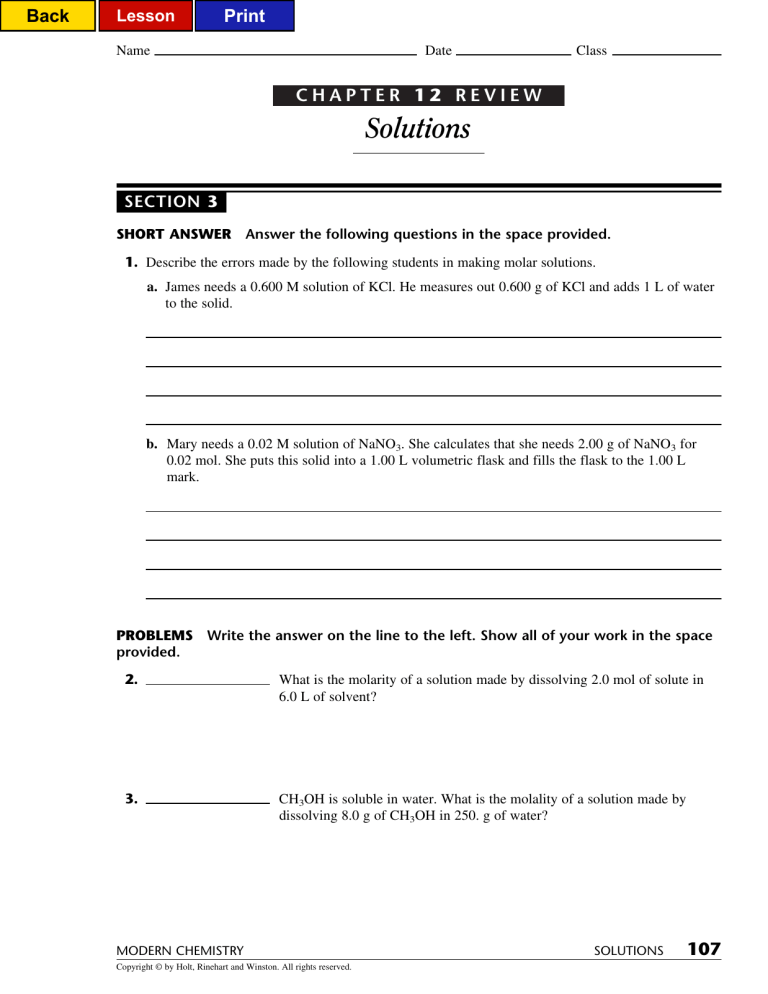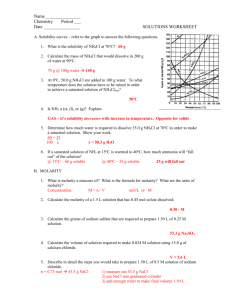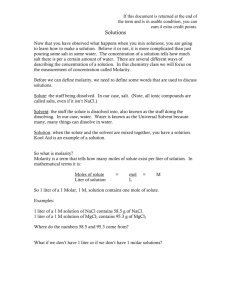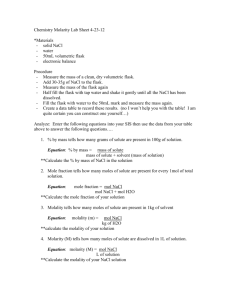Solutions

Back Lesson Print
C H A P T E R 1 2 R E V I E W
Solutions
SECTION
3
SHORT ANSWER Answer the following questions in the space provided.
1.
Describe the errors made by the following students in making molar solutions.
a.
James needs a 0.600 M solution of KCl. He measures out 0.600 g of KCl and adds 1 L of water to the solid.
b.
Mary needs a 0.02 M solution of NaNO
3
. She calculates that she needs 2.00 g of NaNO
3 for
0.02 mol. She puts this solid into a 1.00 L volumetric flask and fills the flask to the 1.00 L mark.
PROBLEMS Write the answer on the line to the left. Show all of your work in the space provided.
2.
What is the molarity of a solution made by dissolving 2.0 mol of solute in
6.0 L of solvent?
3.
CH
3
OH is soluble in water. What is the molality of a solution made by dissolving 8.0 g of CH
3
OH in 250. g of water?
MODERN CHEMISTRY
Copyright © by Holt, Rinehart and Winston. All rights reserved.
SOLUTIONS
107
Back Lesson Print
SECTION 3 continued
4.
Marble chips effervesce when treated with hydrochloric acid. This reaction is represented by the following equation:
CaCO
3
( s ) 2HCl( aq )
→
CaCl
2
( aq ) CO
2
( g ) H
2
O( l )
To produce a reaction, 25.0 mL of 4.0 M HCl is added to excess CaCO
3
.
a.
How many moles of HCl are consumed in this reaction?
b.
How many liters of CO
2 are produced at STP?
c.
How many grams of CaCO
3 are consumed?
5.
Tincture of iodine is I
2
( s ) dissolved in ethanol, C
2
H
5
OH. A 1% solution of tincture of iodine is
10.0 g of solute for 1000. g of solution.
a.
How many grams of solvent are present in 1000. g of this solution?
b.
How many moles of solute are in 10.0 g of I
2
?
c.
What is the molality of this 1% solution?
d.
To determine a solution’s molarity, the density of that solution can be used. Explain how you would use the density of the tincture of iodine solution to calculate its molarity.
108
SOLUTIONS MODERN CHEMISTRY
Copyright © by Holt, Rinehart and Winston. All rights reserved.
Back Lesson Print
C H A P T E R 1 2 R E V I E W
Solutions
SECTION
3
SHORT ANSWER Answer the following questions in the space provided.
1.
Describe the errors made by the following students in making molar solutions.
a.
James needs a 0.600 M solution of KCl. He measures out 0.600 g of KCl and adds 1 L of water to the solid.
James made several errors. First, 0.600 mol of KCl does not have a mass of 0.600 g.
Also, adding 1.0 L of water to the solid does not produce 1.0 L of solution. He did not make a 0.600 M solution.
b.
Mary needs a 0.02 M solution of NaNO
3
. She calculates that she needs 2.00 g of NaNO
3 for
0.02 mol. She puts this solid into a 1.00 L volumetric flask and fills the flask to the 1.00 L mark.
Mary did not produce the required solution either. First, 0.02 mol of NaNO
3 has a mass of 1.70 g, not 2.00 g. Also, she should have made sure the solute was completely dissolved before continuing to fill the volumetric flask to the 1.00 L mark.
PROBLEMS Write the answer on the line to the left. Show all of your work in the space provided.
2.
0.33 M
What is the molarity of a solution made by dissolving 2.0 mol of solute in
6.0 L of solvent?
3.
1.0 m
CH
3
OH is soluble in water. What is the molality of a solution made by dissolving 8.0 g of CH
3
OH in 250. g of water?
MODERN CHEMISTRY
Copyright © by Holt, Rinehart and Winston. All rights reserved.
SOLUTIONS
107
Back Lesson Print
SECTION 3 continued
4.
Marble chips effervesce when treated with hydrochloric acid. This reaction is represented by the following equation:
CaCO
3
( s ) 2HCl( aq )
→
CaCl
2
( aq ) CO
2
( g ) H
2
O( l )
To produce a reaction, 25.0 mL of 4.0 M HCl is added to excess CaCO
3
.
0.10 mol a.
How many moles of HCl are consumed in this reaction?
1.1 L b.
How many liters of CO
2 are produced at STP?
5.0 g c.
How many grams of CaCO
3 are consumed?
5.
Tincture of iodine is I
2
( s ) dissolved in ethanol, C
2
H
5
OH. A 1% solution of tincture of iodine is
10.0 g of solute for 1000. g of solution.
990. g a.
How many grams of solvent are present in 1000. g of this solution?
0.0394 mol b.
How many moles of solute are in 10.0 g of I
2
?
0.0398 m c.
What is the molality of this 1% solution?
d.
To determine a solution’s molarity, the density of that solution can be used. Explain how you would use the density of the tincture of iodine solution to calculate its molarity.
The density of a solution can be expressed in g/mL or in kg/L. Divide 1.00 kg by the solution’s density to find the volume of solution in liters. Then divide 0.0394 mol by this volume to arrive at the molarity.
108
SOLUTIONS MODERN CHEMISTRY
Copyright © by Holt, Rinehart and Winston. All rights reserved.








